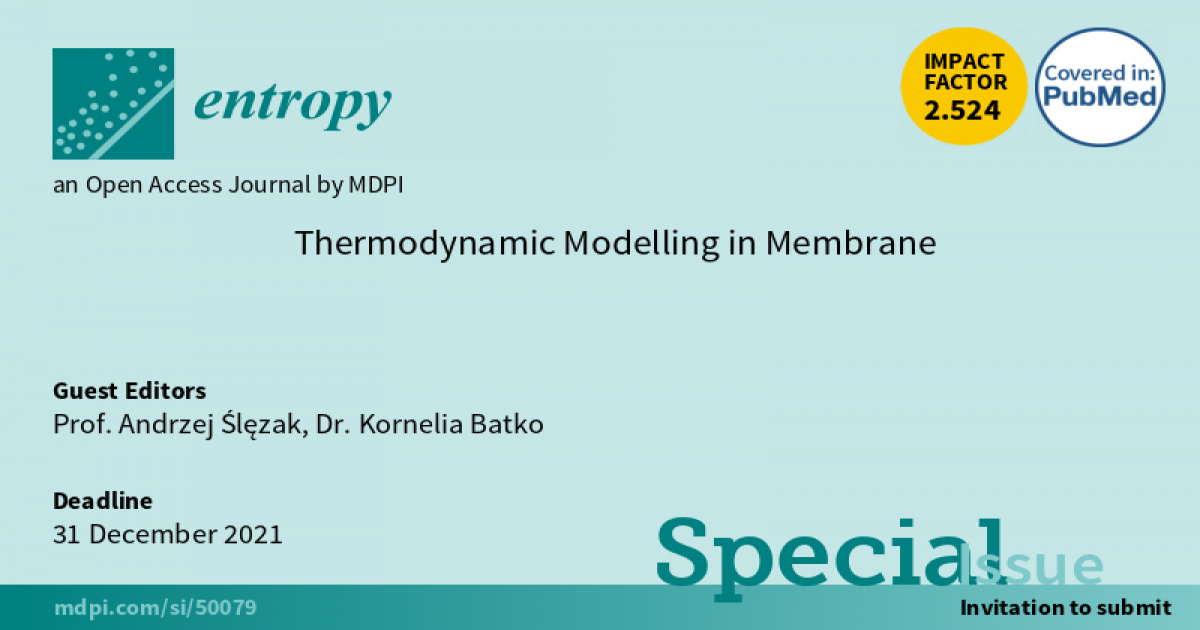- 2.0Impact Factor
- 5.2CiteScore
- 22 daysTime to First Decision
Thermodynamic Modelling in Membrane
This special issue belongs to the section “Thermodynamics“.
Special Issue Information
Dear Colleagues,
Membrane transport (mass, charge, energy, etc.) through artificial and biological membranes, generated by various thermodynamic forces, is one of the basic processes occurring in thermodynamic systems. It is even believed that the biological membrane, which reacts to external factors, acts as a cell management center.
A convenient way to study membrane transport is through the construction of thermodynamic models and, if possible, their experimental verification or falsification. In recent years, numerous papers have been devoted to basic and utilitarian research (engineering, biomedical, etc.) of membrane transport through various types of artificial membranes and their systems.
We invite scientists to submit original research and/or review papers focused on this important area of membrane science, the field of thermodynamic modeling of transport in membrane systems, emphasizing recent findings and developments, future challenges, and/or new opportunities in which to develop guidelines for future research directions.
This Special Issue will accept unpublished original papers and comprehensive reviews focused on (but not restricted to) the following research areas:
- theoretical analyses of membrane transport phenomena
- experimental results on membrane permeation and selectivity
- membrane formation and structure and their relation to transport properties
- nonequilibrium thermodynamics
- network thermodynamics
- membrane formation
- thermodynamic properties of membrane
- passive and active membrane transport processes
- concentration polarization conditions
- membrane dressing
- controlled release of substances
- membrane potentials
- energy, exergy, and entropy generation
- composite membranes
Hence, this Special Issue will serve as the ideal venue for the publication of new developments in the membrane field.
Prof. Andrzej Ślęzak
Dr. Kornelia Batko
Guest Editors
Manuscript Submission Information
Manuscripts should be submitted online at www.mdpi.com by registering and logging in to this website. Once you are registered, click here to go to the submission form. Manuscripts can be submitted until the deadline. All submissions that pass pre-check are peer-reviewed. Accepted papers will be published continuously in the journal (as soon as accepted) and will be listed together on the special issue website. Research articles, review articles as well as short communications are invited. For planned papers, a title and short abstract (about 250 words) can be sent to the Editorial Office for assessment.
Submitted manuscripts should not have been published previously, nor be under consideration for publication elsewhere (except conference proceedings papers). All manuscripts are thoroughly refereed through a single-blind peer-review process. A guide for authors and other relevant information for submission of manuscripts is available on the Instructions for Authors page. Entropy is an international peer-reviewed open access monthly journal published by MDPI.
Please visit the Instructions for Authors page before submitting a manuscript. The Article Processing Charge (APC) for publication in this open access journal is 2600 CHF (Swiss Francs). Submitted papers should be well formatted and use good English. Authors may use MDPI's English editing service prior to publication or during author revisions.
Keywords
- nonequilibrium thermodynamics
- network thermodynamics
- membrane formation
- thermodynamic properties of membrane
- passive and active membrane transport processes
- concentration polarization conditions
- membrane dressing
- controlled release of substances
- membrane potentials
- energy, exergy, and entropy generation
- composite membranes

Benefits of Publishing in a Special Issue
- Ease of navigation: Grouping papers by topic helps scholars navigate broad scope journals more efficiently.
- Greater discoverability: Special Issues support the reach and impact of scientific research. Articles in Special Issues are more discoverable and cited more frequently.
- Expansion of research network: Special Issues facilitate connections among authors, fostering scientific collaborations.
- External promotion: Articles in Special Issues are often promoted through the journal's social media, increasing their visibility.
- e-Book format: Special Issues with more than 10 articles can be published as dedicated e-books, ensuring wide and rapid dissemination.
Related Special Issues
- Thermodynamic Modelling in Membrane, 2nd EditioninEntropy (1 article)

